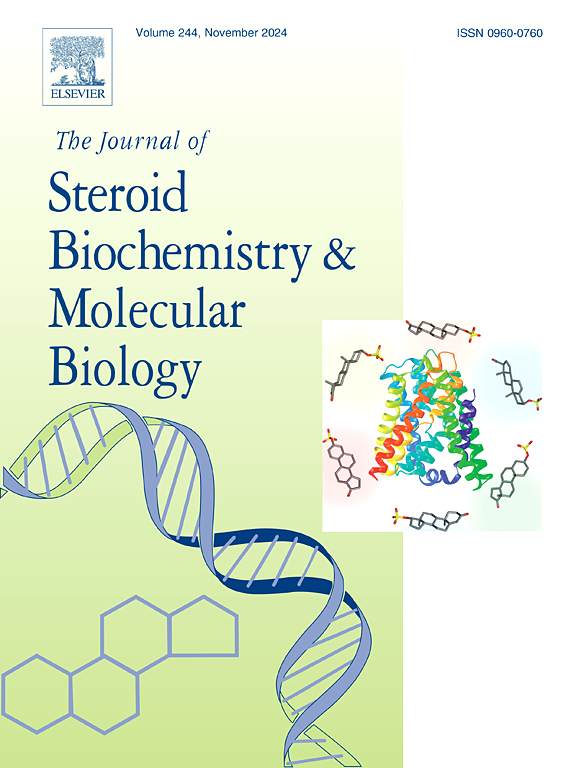功能化二氧化硅纳米颗粒固定化胆固醇氧化酶用于胆固醇和7-酮胆固醇的生物转化。
IF 2.5
2区 生物学
Q3 BIOCHEMISTRY & MOLECULAR BIOLOGY
Journal of Steroid Biochemistry and Molecular Biology
Pub Date : 2025-05-08
DOI:10.1016/j.jsbmb.2025.106774
引用次数: 0
摘要
胆固醇氧化会导致7-酮胆固醇(7KC)等几种氧化甾醇的产生,这与各种与年龄有关的疾病有关。提出了一种降低其毒性的方法,利用微生物来源的酶来降解它们。我们早期的研究发现铜绿假单胞菌PseA和红红红球菌MTCC 3951是能够以7KC作为唯一碳源的潜在菌株。这些菌株产生胆固醇氧化酶作为降解途径的主要酶。采用共价偶联的方法,将铜绿假单胞菌(P. aeruginosa) PseA (ChOxP)、红孢霉(R. erythropolis) MTCC 3951 (ChOxR)和Streptomyces sp. (ChOxS)的商业变体胆固醇氧化酶(ChOx)固定在硅烷功能化二氧化硅纳米颗粒(SNP)上,以提高其适用性。ChOxP、ChOxR和ChOxS的固定化效率分别为68%、86%和83%。固定化酶的催化效率几乎是游离酶的两倍,在较宽的温度(10-70℃)和pH(4.0-9.0)范围内具有更高的稳定性,尽管最佳pH(7.5)和温度(30℃)保持不变。纳米固定的胆固醇氧化酶可重复使用10次。通过红外光谱(FTIR)、扫描电镜(SEM)和透射电镜(TEM)验证了酶在纳米颗粒上的固定化。利用纳米生物偶联物对胆固醇和7KC进行生物转化,分别产生具有重要药理意义的分子4-胆固醇-3- 1和4-胆固醇-3,7-二酮。本文章由计算机程序翻译,如有差异,请以英文原文为准。
Immobilization of cholesterol oxidases on functionalized Silica Nanoparticles for biotransformation of cholesterol and 7-ketocholesterol
Cholesterol oxidation leads to the development of several oxysterols such as 7-ketocholesterol (7KC), which are linked to various age-related conditions. An approach to reduce their toxicity is proposed using enzymes from microbial sources to degrade them. Our earlier studies identified Pseudomonas aeruginosa PseA and Rhodococcus erythropolis MTCC 3951 as potential strains capable of using 7KC as their sole carbon source. These strains produced cholesterol oxidase as the primary enzyme in the degradation pathway. To enhance applicability, cholesterol oxidase (ChOx) enzymes from P. aeruginosa PseA (ChOxP), R. erythropolis MTCC 3951 (ChOxR), and a commercial variant from Streptomyces sp. (ChOxS) were immobilized on silane functionalized silica nanoparticles (SNP) using covalent-coupling methods. The immobilization efficiency was 68 %, 86 %, and 83 % for ChOxP, ChOxR, and ChOxS respectively. The catalytic efficiency of the immobilized enzyme was nearly twice that of the free enzyme, with increased stability across a wide range of temperatures (10–70°C) and pH levels (4.0–9.0), although the optimum pH (7.5) and temperature (30°C) remained unchanged. The nano-immobilized cholesterol oxidases were reusable up to 10 cycles. Further, enzyme immobilization on nanoparticles was confirmed by FTIR, SEM, and TEM. Biotransformation of cholesterol and 7KC using the nanobioconjugates produced pharmaceutically important molecules 4-cholesten-3-one and 4-cholesten-3,7-dione respectively.
求助全文
通过发布文献求助,成功后即可免费获取论文全文。
去求助
来源期刊
CiteScore
8.60
自引率
2.40%
发文量
113
审稿时长
46 days
期刊介绍:
The Journal of Steroid Biochemistry and Molecular Biology is devoted to new experimental and theoretical developments in areas related to steroids including vitamin D, lipids and their metabolomics. The Journal publishes a variety of contributions, including original articles, general and focused reviews, and rapid communications (brief articles of particular interest and clear novelty). Selected cutting-edge topics will be addressed in Special Issues managed by Guest Editors. Special Issues will contain both commissioned reviews and original research papers to provide comprehensive coverage of specific topics, and all submissions will undergo rigorous peer-review prior to publication.

 求助内容:
求助内容: 应助结果提醒方式:
应助结果提醒方式:


